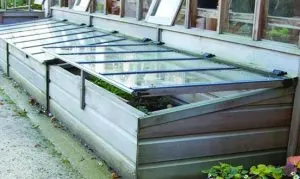With a cold frame greenhouse – wintertime doesn’t mean the end of growing fresh garden produce!
A cold frame greenhouse is an excellent way to extend growing fresh vegetables past summer. They work wonders in late fall, early spring – and even in the dead of winter.
We use our current cold frames to grow lettuce, kale, spinach, radishes and more. All right through the coldest days of winter.
Greens do particularly well through winter because of their ability to tolerate cold temperatures. It is an easy way to keep your household in fresh salads long after your main garden has been put to bed.
What Is A Cold Frame Greenhouse?
A cold frame greenhouse is any structure with four walls and a top designed to let in sunlight. The sun’s rays heat the soil and surrounding air in the cold frame during the day. That heat can be held in long enough through cold nights to keep plants from freezing.
Creating a homemade cold frame greenhouse is a simple process. It can be as easy as stacking up a few bales of straw, filling with a soil and compost, and topping off with a clear cover to let in light. Both clear plastic and glass will work. Of the two, we have found glass to work best.
We built our first cold frames from some scrap lumber and a few old window panes. (see: Building and Using a Cold Frame). It has served us well over the past few years.
So well in fact, that we hope to expand on the original concept and build a more permanent cold frame greenhouse this winter. (See photo at the bottom for the prototype)
Locating and Using Your Cold Frame Greenhouse
Cold frames need a sunny, southern-facing location to perform at their best. We fill ours with an equal combination of fertile potting soil and compost. We seed a few rows of lettuce every few weeks through the winter to keep a steady supply of fresh greens coming.
Controlling the temperature inside of the cold frame is the key to growing success. For cooler loving crops like spinach, kale and lettuce, 50 to 60 degrees is ideal.
On warmer winter days, you may need to prop up the glass or plastic top to keep the soil and plants from overheating. Those same tops need to be closed at night to keep your veggies from frost or freezing.
When we build our larger cold frame greenhouse this winter, (look for a complete article and plans coming in late January on the blog) we will be installing inexpensive temperature control arms that prop the windows up when the temperature gets too hot, or close when it drops to cold.
We are certainly anxious to see how it works!
Here’s to growing a little more of your food in a cold frame greenhouse! Jim and Mary.
To receive our 3 Home, Garden, Recipe and Simple Life articles each week, sign up for our free email list. You can also follow us on Facebook, Twitter, Pinterest, or Instagram. This article may contain affiliate links.



